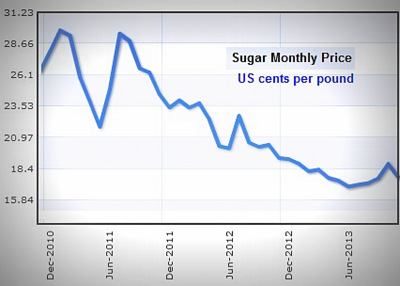KING WAN CORP is an interesting company highlighted by a few readers. It is not a straightforward company to describe given its diverse businesses.
Bloomberg describes it as a company which provides mechanical and electrical engineering services. The Company also owns, rents, operates mobile lavatories and other facilities, makes UPVC pipes and fittings, and develops properties.
It also makes and sells paints, varnishes and painting inks.
I assure you it is more than what Bloomberg said, which you will read about in later paragraphs.
 King Wan's 5-year chart by Bloomberg.
King Wan's 5-year chart by Bloomberg.As we can see from the chart, King Wan garnered substantial investor interest in 2013.
Its price rose sharply from 20 cents and stabilised in the trading range between 27 to 32 cents.
At the last traded price of 29 cents, is there further upside?
At 29 cents, King Wan has the following snapshot:
* 2013 dividends = 1.5 cents, giving it a dividend yield = 5.2%
* conservatively financed = borrowings of $10.5 mil, representing a debt-to-equity ratio of 12%
* annualised EPS = 2.64, giving a price-to-earnings (PE) of 11
* net asset value (NAV) is 24.68 cents, hence trading at a 18% premium to its NAV.
So based on historicals, King Wan is not exactly screaming cheap.
Hence, Mr Market must be pricing in certain expectations about the future.
My guess is that a lot of the recent interest in King Wan is broadly due to two expectations.
Expectation #1 - Special Dividends
(a) from sale of Thai Associates EPPCO and EPC
(b) IPO of Kaset Thai Industry Sugar Co (KTIS) which King Wan has a 2-3% stake
Expectation #2 - Near term high dividend yields
King Wan's M&E business is strong enough to support the 1.5 cents dividends / or 5.2% dividend yield.
Depending on what King Wan intends to do after its KTIS shares are listed, the dividend yields can go up further.
Put it this way, at the current price, a 10% dividend yield would entail an annual cash outflow of $10.1 mil. (2.9 cents x 349,176,870 shares), some of which can be supported by its M&E business.
 Sugar price chart by http://www.indexmundi.comThe remainder can be supported by King Wan selling off its KTIS shares which is worth $48 million.
Sugar price chart by http://www.indexmundi.comThe remainder can be supported by King Wan selling off its KTIS shares which is worth $48 million. Not something inconceivable but if I were King Wan, I would take my time to assess the price before selling. A gradual sale over the next few years depending on market conditions is expected.
In any case, sugar prices are at the low end, so there could be further upside in the prices for KTIS.
Should King Wan decide to hold, shareholders are staring at a likely sustainable 5.2% dividend yield anyhow.
Areas to Look Out For
There is rarely a perfect stock out there. Similarly, for the case of King Wan, there are areas where a cautious investor should keep tabs on.
(a) Opportunistic Nature of Management's Capital Deployment
 Ms Chua Eng Eng, 42, is MD of King Wan Corp. Photo: CompanyI was doing some online scuttle-butt research on King Wan and learnt that back in January 2013, the company took a 30% stake in a bulk carrier - PURELY for investment.
Ms Chua Eng Eng, 42, is MD of King Wan Corp. Photo: CompanyI was doing some online scuttle-butt research on King Wan and learnt that back in January 2013, the company took a 30% stake in a bulk carrier - PURELY for investment. The business case is utterly simple. The original buyer couldn't pay up, there was an existing charter and hence positive cash inflows for the charter period (3 years from Mar 2013).
There is also potential for further upside should ship prices go up in future.
I would not be surprised if going forward, management considers opportunities from other sectors. While there is nothing wrong with deploying money to where returns are, it makes the business very hard to predict, and you can't help but wonder what competitive advantages do King Wan in those new ventures.
As an opmi, you already have limited insights to the business and now, you have to place absolute trust in management's ability to ensure the money is put into good use.
(b) No more dividends and profit contribution post-disposal of EPPCO and EPC
In 2012, EPPCO and EPC contributed $0.9 million to the bottom line. Going forward, the bottom line gap has to be made up by stronger performance from M&E or new businesses.
Conclusion
Mr Market is irrational sometimes but my feel is that likely some / if not most of the expectations may have been priced in for King Wan.
Having said that, I have a bad track record at gauging Mr Market's emotions. King Wan's expected dividend yields for the next few years should be the main attraction to interested investors, especially given the lack of solid alternatives in the market (look at the REITs which have taken some hammering).
Of course, that is, if we are sure management will leave the money on the table for distribution to shareholders. After all, they seem to be all over the place when it comes to sourcing opportunities.
Recent story: Expect King Wan's 2.5-c reward; $1.00 target for Sino Grandness







